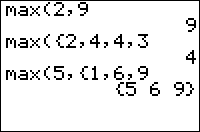TI-BASIC:Max
Command Summary
Returns the maximum of two elements or of a list.
Command Syntax
- for two numbers: max(x,y)
- for a list: max(list)
- comparing a number to each element of a list: max(x,list) or max(list,x)
- pairwise comparing two lists: max(list1,list2)
Menu Location
Press:
- MATH to access the Math menu.
- RIGHT to access the NUM submenu.
- 7 to select max(, or use arrows.
Alternatively, press:
- 2nd LIST to access the list menu.
- LEFT to access the MATH submenu.
- 2 to select max(, or use arrows.
TI-83/84/+/SE
1 byte
max(x,y) returns the largest of the two numbers x and y. max(list) returns the largest element of list. max(list1,list2) returns the pairwise maxima of the two lists. max(list1,x) (equivalently, max(x,list1)) returns a list whose elements are the larger of x or the corresponding element of the original list.
max(2,3)
3
max({2,3,4})
4
max({1,3},{4,2})
{4 3}
max({1,3},2)
{2 3}
Unlike comparison operators such as < and >, max( can also compare complex numbers. To do this, both arguments must be complex -- either complex numbers or complex lists: max(2,i) will throw an error even though max(2+0i,i) won't. In the case of complex numbers, the number with the largest absolute value will be returned. When the two numbers have the same absolute value, the first one will be returned: max(i,-i) returns i and max(-i,i) returns -i.
Advanced Uses
max( can be used in Boolean comparisons to see if at least one of a list is 1 (true) -- useful because commands like If or While only deal with numbers, and not lists, but comparisons like L1=L2 return a list of values. In general, the behavior you want varies, and you will use the Min( function or the max( function accordingly.
Using max( will give you a lenient test -- if any one element of the list is 1 (true), then the max( of the list is true -- this is equivalent to putting an 'or' in between every element. For example, this tests if K is equal to any of 24, 25, 26, or 34 (the GetKey arrow key values):
:If max(K={24,25,26,34
:Disp "ARROW KEY
To get the element of a real list with the greatest absolute value, use imag(max(iAns.
Error Conditions
- ERR:DATA TYPE is thrown when comparing a real and a complex number. This can be avoided by adding +0i to the real number (or i^4 right after it, for those who are familiar with complex numbers)
- ERR:DIM MISMATCH is thrown, when using max( with two lists, if they have different dimensions.
